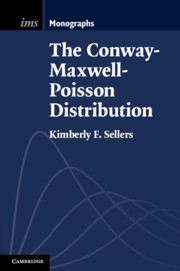Book contents
- Frontmatter
- Dedication
- Contents
- Figures
- Tables
- Preface
- Acknowledgments
- 1 Introduction: Count Data Containing Dispersion
- 2 The Conway–Maxwell–Poisson (COM–Poisson) Distribution
- 3 Distributional Extensions and Generalities
- 4 Multivariate Forms of the COM–Poisson Distribution
- 5 COM–Poisson Regression
- 6 COM–Poisson Control Charts
- 7 COM–Poisson Models for Serially Dependent Count Data
- 8 COM–Poisson Cure Rate Models
- References
- Index
4 - Multivariate Forms of the COM–Poisson Distribution
Published online by Cambridge University Press: 02 March 2023
- Frontmatter
- Dedication
- Contents
- Figures
- Tables
- Preface
- Acknowledgments
- 1 Introduction: Count Data Containing Dispersion
- 2 The Conway–Maxwell–Poisson (COM–Poisson) Distribution
- 3 Distributional Extensions and Generalities
- 4 Multivariate Forms of the COM–Poisson Distribution
- 5 COM–Poisson Regression
- 6 COM–Poisson Control Charts
- 7 COM–Poisson Models for Serially Dependent Count Data
- 8 COM–Poisson Cure Rate Models
- References
- Index
Summary
A multivariate Poisson distribution is a natural choice for modeling count data stemming from correlated random variables; however, it is limited by the underlying univariate model assumption that the data are equi-dispersed. Alternative models include a multivariate negative binomial and a multivariate generalized Poisson distribution, which themselves suffer from analogous limitations as described in Chapter 1. While the aforementioned distributions motivate the need to instead consider a multivariate analog of the univariate COM–Poisson, such model development varies in order to take into account (or results in) certain distributional qualities. This chapter summarizes such efforts where, for each approach, readers will first learn about any bivariate COM–Poisson distribution formulations, followed by any multivariate analogs. Accordingly, because these models are multidimensional generalizations of the univariate COM–Poisson, they each contain their analogous forms of the Poisson, Bernoulli, and geometric distributions as special cases. The methods discussed in this chapter are the trivariate reduction, compounding, Sarmanov family of distributions, and copulas.
Keywords
Information
- Type
- Chapter
- Information
- The Conway–Maxwell–Poisson Distribution , pp. 124 - 152Publisher: Cambridge University PressPrint publication year: 2023
